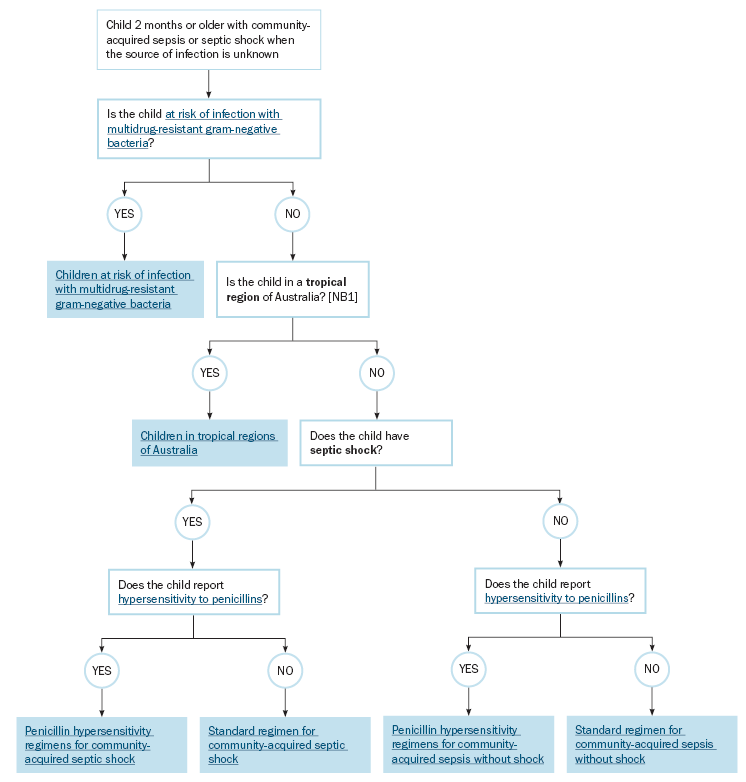General approach to managing community-acquired sepsis or septic shock of unknown source in children 2 months or older
The following empirical regimens are intended for initial therapy only (up to 48 hours). Modify therapy as soon as additional information is available (eg source of infection, results of Gram stain, culture and susceptibility testing). Evaluate the appropriateness of antimicrobial therapy daily, with consideration given to the child’s clinical status and the principles of antimicrobial stewardshipBurston, 2017.
For advice on recognising sepsis and septic shock, see Identifying sepsis and septic shock and for advice on early management, see Resuscitation of patients with sepsis and septic shock.
To find the right empirical antibiotic regimen for children 2 months or older with community-acquired sepsis or septic shock of unknown source, use Finding the right empirical antibiotic regimen for children 2 months or older with community-acquired sepsis or septic shock of unknown source.
For children 2 months or older with sepsis or septic shock who have no clear source of infection at the time of recognition, data suggest that the likely pathogens involved include Staphylococcus aureus, Streptococcus pneumoniae, Streptococcus pyogenes and Neisseria meningitidis. The empirical regimens in these guidelines are intended to provide adequate spectrum of activity to treat these pathogens, while awaiting the results of culture and susceptibility testing.
In these guidelines, either a cephalosporin-based or a meropenem-based regimen is recommended for community-acquired sepsis or septic shock in children 2 months or older, depending on the risk of infection with multidrug-resistant gram-negative bacteria or Burkholderia pseudomallei. For children with:
- septic shock, a 3-drug regimen is recommended to ensure adequate treatment of bacteria not susceptible to cefotaxime and ceftriaxone (eg some strains of S. pneumoniae, methicillin-resistant S. aureus [MRSA], some strains of gram-negative bacteria)
- sepsis without septic shock and who do not have risk factors for infection with multidrug-resistant gram-negative bacteria or B. pseudomallei, cefotaxime or ceftriaxone may be used alone, or combined with vancomycin if the child is at increased risk of infection with MRSA
- risk factors for infection with multidrug-resistant gram-negative bacteria and those in tropical regions of Australia1, where infection with B. pseudomallei is possible, meropenem-based empirical regimens are recommended.
The regimens in these guidelines may also need to be modified according to local epidemiology, if known.

NB1: Tropical regions of Australia refer to regions north of 20°S latitude. This includes areas of Queensland north of Mackay, the Northern Territory north of Tennant Creek, and Western Australia north of Port Hedland.
